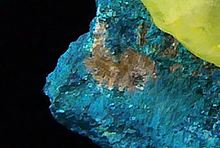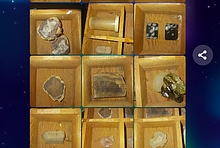Home PageAbout MindatThe Mindat ManualHistory of MindatCopyright StatusWho We AreContact UsAdvertise on Mindat
Donate to MindatCorporate SponsorshipSponsor a PageSponsored PagesMindat AdvertisersAdvertise on Mindat
Learning CenterWhat is a mineral?The most common minerals on earthInformation for EducatorsMindat ArticlesThe ElementsThe Rock H. Currier Digital LibraryGeologic Time
Minerals by PropertiesMinerals by ChemistryAdvanced Locality SearchRandom MineralRandom LocalitySearch by minIDLocalities Near MeSearch ArticlesSearch GlossaryMore Search Options
The Mindat ManualAdd a New PhotoRate PhotosLocality Edit ReportCoordinate Completion ReportAdd Glossary Item
Mining CompaniesStatisticsUsersMineral MuseumsClubs & OrganizationsMineral Shows & EventsThe Mindat DirectoryDevice SettingsThe Mineral Quiz
Photo SearchPhoto GalleriesSearch by ColorNew Photos TodayNew Photos YesterdayMembers' Photo GalleriesPast Photo of the Day GalleryPhotography
╳Discussions
💬 Home🔎 Search📅 LatestGroups
EducationOpen discussion area.Fakes & FraudsOpen discussion area.Field CollectingOpen discussion area.FossilsOpen discussion area.Gems and GemologyOpen discussion area.GeneralOpen discussion area.How to ContributeOpen discussion area.Identity HelpOpen discussion area.Improving Mindat.orgOpen discussion area.LocalitiesOpen discussion area.Lost and Stolen SpecimensOpen discussion area.MarketplaceOpen discussion area.MeteoritesOpen discussion area.Mindat ProductsOpen discussion area.Mineral ExchangesOpen discussion area.Mineral PhotographyOpen discussion area.Mineral ShowsOpen discussion area.Mineralogical ClassificationOpen discussion area.Mineralogy CourseOpen discussion area.MineralsOpen discussion area.Minerals and MuseumsOpen discussion area.PhotosOpen discussion area.Techniques for CollectorsOpen discussion area.The Rock H. Currier Digital LibraryOpen discussion area.UV MineralsOpen discussion area.Recent Images in Discussions
GeneralType Localities
9th Nov 2017 17:56 UTCKevin Conroy Manager

9th Nov 2017 18:07 UTCAlfredo Petrov Manager
So, after 1959, all newly described minerals should have a type locality, except in a few cases when the description was done on museum material of dubious heritage, or when scientists labored under secretive regimes which refused to allow them to divulge an accurate TL. Pre-IMA, it's a lot more fuzzy, and any attempt to compile a list of type localities, or no type localities, will be rife with debatable entries.
9th Nov 2017 22:56 UTCDavid Von Bargen Manager
Allanite-(Y)
Calcioancylite-(Ce)
Chambersite
Clinoenstatite
Cummingtonite
Ferro-actinolite
Ferro-gedrite
Ferro-hornblende
Ferro-pargasite
Ferro-richterite
Ferrosilite
Fluorapophyllite-(K)
Fluornatroroméite
Fluorstrontiopyrochlore
Gersdorffite-P213
Gersdorffite-Pa3
Gersdorffite-Pca21
Gismondine-Ca
Hydromicrolite
Iridium
Maghagendorfite
Magnesio-hornblende
Merrillite
Oxycalciomicrolite
Oxyplumbopyrochlore
Phlogopite
Potassic-chloro-pargasite
Potassicmendeleevite-(Ce)
Stilbite-Ca
Trilithionite
Yttrocolumbite-(Y)
End of report
IMA grandfathered minerals with no type locality
Actinolite
Åkermanite
Alum-(K)
Alum-(Na)
Alunogen
Andorite VI
Ankerite
Arsenic
Arsenopyrite
Asbolane
Augite
Baryte
Beryl
Bismuthinite
Calcite
Calclacite
Cassiterite
Chalcocite
Chalcophyllite
Chalcopyrite
Chrysocolla
Cinnabar
Cobaltite
Columbite-(Mn)
Copper
Corundum
Cuprite
Diamond
Diopside
Dolomite
Domeykite-β
Enstatite
Galena
Gold
Graphite
Gypsum
Halite
Halotrichite
Hematite
Hydroxylapatite
Hydroxylherderite
Ice
Kalinite
Kyanite
Lead
Magnetite
Malachite
Marcasite
Melanterite
Mercury
Mesolite
Minium
Mirabilite
Molybdenite
Natron
Nickeline
Niter
Nováčekite-II
Opal
Orpiment
Orthoclase
Osmium
Polybasite
Proustite
Pyrargyrite
Pyrite
Pyrolusite
Pyroxmangite
Pyrrhotite
Quartz
Realgar
Salammoniac
Schorl
Scolecite
Selenium
Siderite
Silver
Smithsonite
Spangolite
Sphalerite
Spinel
Staurolite
Stibnite
Sulphur
Talc
Thermonatrite
Topaz
Trona
Turquoise
Vaterite
Whewellite
Winchite
Wollastonite
9th Nov 2017 23:07 UTCReiner Mielke Expert
IMA No. 2017-059
Magnesio-hornblende
□Ca2(Mg4Al)(Si7Al)O22(OH)2
Sand dunes of Lüderitz, Karas Region, Namibia (26°38′52″S, 15°09′28″E)
Roberta Oberti*, Massimo Boiocchi, Frank C. Hawthorne and Marco E. Ciriotti
*E-mail: oberti@crystal.unipv.it
Amphibole supergroup
Monoclinic: C2/m; structure determined
a = 9.8308(7), b = 18.0659(11), c = 5.2968(4) Å, β = 104.771(6)°
8.412(74), 3.386(48), 3.121(72), 2.709(100), 2.596(45), 2.541(57), 2.338(41), 2.164(39)
Type material is deposited in the collections of the Museo di Mineralogia, Sistema Museale di Ateneo, University of Pavia, Italy, catalogue number 2017-01
How to cite: Oberti, R., Boiocchi, M., Hawthorne, F.C. and Ciriotti, M.E. (2017) Magnesio-hornblende, IMA 2017-059. CNMNC Newsletter No. 39, October 2017, page 1284; Mineralogical Magazine, 81, 1279–1286.
9th Nov 2017 23:33 UTCDavid Von Bargen Manager
10th Nov 2017 01:22 UTCKevin Conroy Manager

10th Nov 2017 03:17 UTCAlfredo Petrov Manager
10th Nov 2017 14:08 UTCDavid Von Bargen Manager
If one would read the original article, you would find out that it was from the returns from a solution mined petroleum storage facility.
I added the only well in which chambersite was found for the initial description.

10th Nov 2017 16:29 UTCTony Albini
10th Nov 2017 16:59 UTCDavid Von Bargen Manager

10th Nov 2017 17:12 UTCAlfredo Petrov Manager
How large is a type locality? Unfortunately, collectors very unscientifically link the TL to a "locality name", which might be a 3cm wide veinlet (in the case of the El Dragon selenium minerals), or a 3km wide open pit (in the case of Chuquicamata), or a whole country. So if I find a rare selenium mineral whose type locality is the "El Dragon mine" in another veinlet on an adjoining prospect a couple hundred meters away, is that from the type locality? Collectors say no, because the locality name is different. We even have cases where a mineral whose TL is the Animas mine is not considered a TL specimen if it came from the same vein extending over the boundary into an adjacent mine. But if a rare mineral came from "Chuquicamata" type locality, and I find more of it in a veinlet at the other end of the pit, kilometers away, that is a type locality piece, because the locality name is the same! Absurd. It's basing the concept of type locality on political boundaries rather than geological/paragenetic boundaries. But what do scientists say about this? Well, they don't say much of anything about it, because the whole concept of TL is of little importantance to mineralogy, only the type specimen is important. Basically it's only collectors who want to quibble about this. If it were up to me, I'd define TL according to the geological Formation the type specimen was found in.
10th Nov 2017 18:01 UTCJolyon Ralph Founder
Exactly this. It gives absolutely zero extra value for a mineral specimen if it comes from the type locality. Unless that is you have part of the type specimen itself.
11th Nov 2017 11:52 UTCJohan Kjellman Expert
-------------------------------------------------------
> Let's keep in mind that "type locality" is a
> concept more important to collectors than to
> mineralogists. For mineralogists it's the "type
> specimen" that's important, and the locality it
> came from is somewhat incidental. And there has
> never really been a proper definition of what
> "type locality" means.
Jolyon & Katya Ralph Wrote:
> Exactly this. It gives absolutely zero extra value for a mineral specimen if it comes from the type locality. Unless that is you have part of the type specimen itself.
value to whom ?
I think mineralogy as a science and the mineral collecting community would booth benefit a lot more if they were taking into consideration the whole tracking history of minerals and their localities, be it types, type localities, original localities, misnomers, discreditations, mistakes...
I wonder why yttrocolumbite is on the A-list here at mindat? It has a Q in the IMA-CMNMC list.
cheers
11th Nov 2017 16:33 UTCUwe Kolitsch Manager

13th Nov 2017 15:12 UTCTony Albini

13th Nov 2017 16:36 UTCGeorg Graf
type specimens are more important than specimens from the type locality. Because in a big mineral deposit a mineral can look on the 2nd level very different from the same mineral on the 10th level. (Crystal form, colour, paragenesis, ...) - In my humble opinion, a mineral specimen is not more worth, if it is from the type locality, but if it is looking like the type specimen.
Good luck, Gg
17th Nov 2017 20:09 UTCRalph S Bottrill 🌟 Manager

17th Nov 2017 22:05 UTCPeter Keller
9th Jan 2018 19:01 UTCKevin Conroy Manager

9th Jan 2018 19:31 UTCIlkka Mikkola
Look at IMA master list: Muskovite was approved in 1998 with s.p. and no TL.
(s.p., special procedure): it refers to the year in which a specific action (redefinition and/or renaming) took place, and was approved by IMA).
Ilkka

9th Jan 2018 19:39 UTCKnut Edvard Larsen 🌟 Manager
9th Jan 2018 21:44 UTCKevin Conroy Manager
9th Jan 2018 22:25 UTCDavid Von Bargen Manager

10th Jan 2018 01:26 UTCAlfredo Petrov Manager
Wikipedia: "The name muscovite comes from Muscovy-glass, a name given to the mineral in Elizabethan England due to its use in medieval Russia as a cheaper alternative to glass in windows. This usage became widely known in England during the sixteenth century with its first mention appearing in letters by George Turberville, the secretary of England's ambassador to the Russian tsar Ivan the Terrible, in 1568."

10th Jan 2018 08:25 UTCErik Vercammen Expert




Mindat.org is an outreach project of the Hudson Institute of Mineralogy, a 501(c)(3) not-for-profit organization.
Copyright © mindat.org and the Hudson Institute of Mineralogy 1993-2024, except where stated. Most political location boundaries are © OpenStreetMap contributors. Mindat.org relies on the contributions of thousands of members and supporters. Founded in 2000 by Jolyon Ralph.
Privacy Policy - Terms & Conditions - Contact Us / DMCA issues - Report a bug/vulnerability Current server date and time: April 18, 2024 10:12:22
Copyright © mindat.org and the Hudson Institute of Mineralogy 1993-2024, except where stated. Most political location boundaries are © OpenStreetMap contributors. Mindat.org relies on the contributions of thousands of members and supporters. Founded in 2000 by Jolyon Ralph.
Privacy Policy - Terms & Conditions - Contact Us / DMCA issues - Report a bug/vulnerability Current server date and time: April 18, 2024 10:12:22











